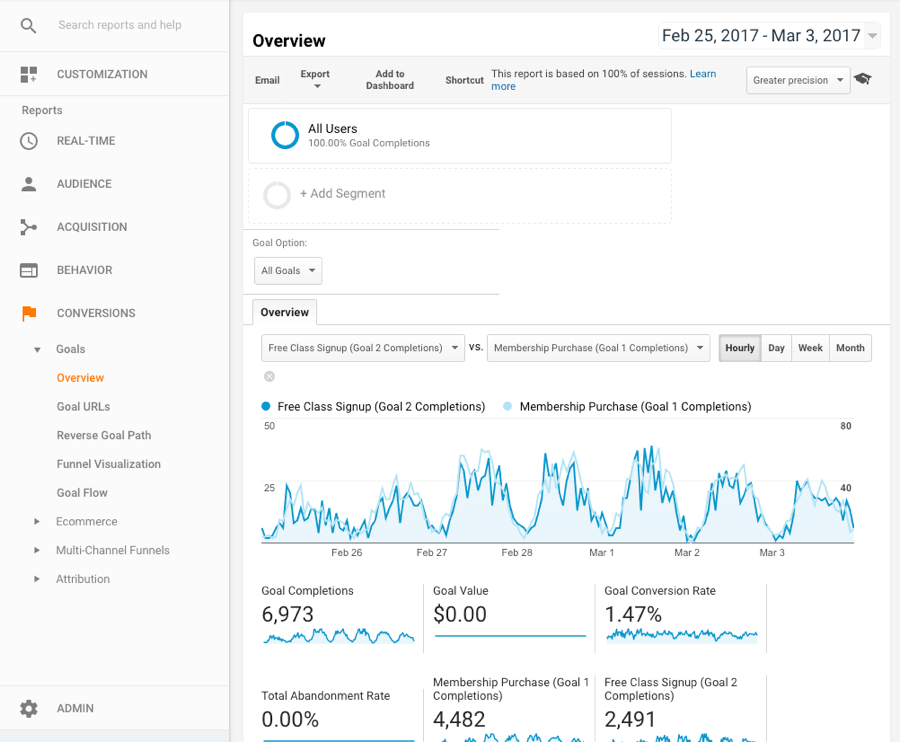Comprehensive Checklist of What Data Is Google Analytics Goals Unable to Track
Comprehensive Checklist of What Data Is Google Analytics Goals Unable to Track
Blog Article
Discover the Limitations of Google Analytics Goals: Revealing the Information Types That Remain Untrackable
As services significantly depend on data-driven decision-making, understanding the restrictions of tools like Google Analytics ends up being critical. While Google Analytics Goals offer beneficial understandings right into user communications, there exist information kinds that avoid tracking, posing difficulties to a thorough understanding of user behavior.
Insufficient Customer Trip Tracking
Insufficient user journey tracking within Google Analytics can impede the capability to properly assess user behavior. When the individual trip is not fully tracked, there are spaces in the data that prevent an extensive understanding of just how customers connect with a site. This lack of understanding can result in missed opportunities for optimization and improvements to the user experience.
One common issue with incomplete user journey monitoring is the lack of ability to see the complete course that individuals take previously finishing an objective or leaving the website. Without this information, it is testing to recognize where customers might be encountering obstacles or rubbing factors that avoid them from converting. In addition, insufficient monitoring can obscure the impact of certain advertising and marketing initiatives or internet site modifications on customer habits.
To resolve this restriction, it is crucial to establish appropriate tracking devices within Google Analytics to record the whole individual trip. This might entail establishing up event monitoring, objective funnels, or utilizing devices like Google Tag Manager to guarantee that no essential communications go unrecorded. By getting a detailed view of the customer journey, web site proprietors can make more enlightened decisions to boost individual engagement and drive conversions.
Acknowledgment Challenges
Browsing via attribution challenges in Google Analytics needs an extensive understanding of just how various touchpoints add to the overall conversion process. Attribution difficulties emerge from the intricacy of modern customer journeys, where users engage with several networks prior to transforming.
One usual acknowledgment challenge is the trouble in associating conversions to the appropriate source, specifically in instances where individuals interact with numerous networks before transforming. Furthermore, cross-device monitoring positions an additional attribution difficulty, as users frequently switch over in between gadgets throughout their journey, making it testing to track their communications effortlessly.
Offline Conversions
Given the difficulties linked with associating conversions accurately in online channels, the dimension of offline conversions presents a considerable possibility for marketers seeking a more detailed understanding of their customers' trip. Offline conversions refer to actions that consumers take in the real world, such as making purchases in brick-and-mortar stores or over the phone, attending events, or involving with published materials - what data is google analytics goals unable to track. These conversions are critical for services that run both online and offline, as they provide useful insights into the efficiency of marketing campaigns throughout various touchpoints
Tracking offline conversions generally positioned a substantial challenge for marketers, as it was challenging to connect these activities back to details on-line interactions precisely. With advancements in innovation, such as the assimilation of CRM systems, distinct identifiers, and discount coupon codes, businesses can now bridge the void in between online and offline information to get a much more all natural sight of consumer actions. By successfully determining offline conversions, online marketers can maximize their methods, assign resources much more successfully, and ultimately boost the total consumer experience.
Cross-Device Monitoring
Cross-device tracking plays an important duty in comprehending the interconnected nature of consumers' electronic interactions across several devices. In today's omnichannel world, where customers effortlessly switch in between tablets, smart devices, and desktops, tracking their actions across these tools is important for online marketers to gain a detailed view of their client trip.

Additionally, privacy problems and regulations such as GDPR and CCPA have further difficult cross-device tracking. With individuals requiring even more control over their information and increased limitations on tracking innovations, marketers need to find innovative and privacy-compliant ways to attach why not check here individual communications throughout devices.
Dynamic Material Interaction
Comprehending user interaction with vibrant web content is essential in enhancing electronic advertising and marketing approaches for improved target market communication. Dynamic web content describes web site aspects that alter based on user actions, preferences, or other elements, offering a tailored experience. Tracking individual communications with vibrant material poses difficulties for standard analytics tools like Google Analytics.
While Google Analytics can track fundamental interactions like clicks and page sights, it might battle to catch more nuanced engagements within vibrant content. what data is google analytics goals unable to track. Metrics such as time spent on details dynamic components, float activities, or communications within pop-ups are usually not easily quantifiable utilizing common monitoring methods. This constraint impedes marketing professionals' capacity to fully realize exactly how users are engaging with vibrant material and customize their methods accordingly

Verdict
To conclude, Google Analytics goals have constraints in tracking incomplete user trips, connecting conversions accurately, catching offline conversions, tracking cross-device communications, and gauging dynamic web content interaction. These constraints highlight the significance of exploring additional tracking methods and devices to gain a much more thorough understanding of user behavior and conversions beyond what Google Analytics can supply.
While Google Analytics Goals offer important understandings right into customer communications, there exist information types that elude tracking, posing challenges to a comprehensive understanding of individual actions.Insufficient customer trip monitoring within Google Analytics can impede the ability to properly assess individual habits. When the user journey is not fully tracked, there are gaps in the information that avoid a thorough try here understanding of just how individuals communicate with a site.One typical issue with insufficient individual trip tracking is the inability to see the full path that individuals take before finishing an objective or leaving visit the website the website. By gaining a comprehensive sight of the individual trip, web site owners can make even more educated choices to boost customer engagement and drive conversions.
Report this page